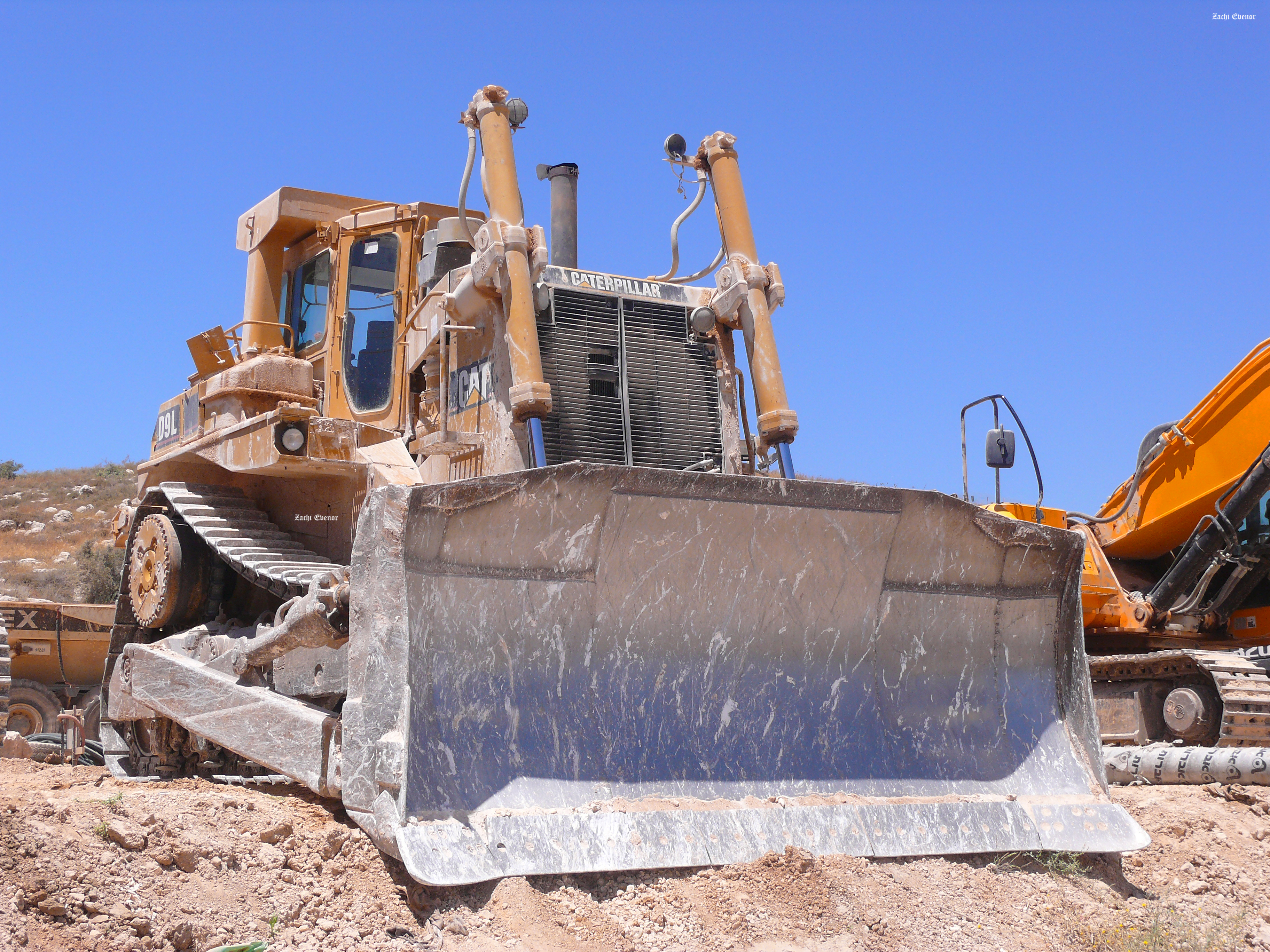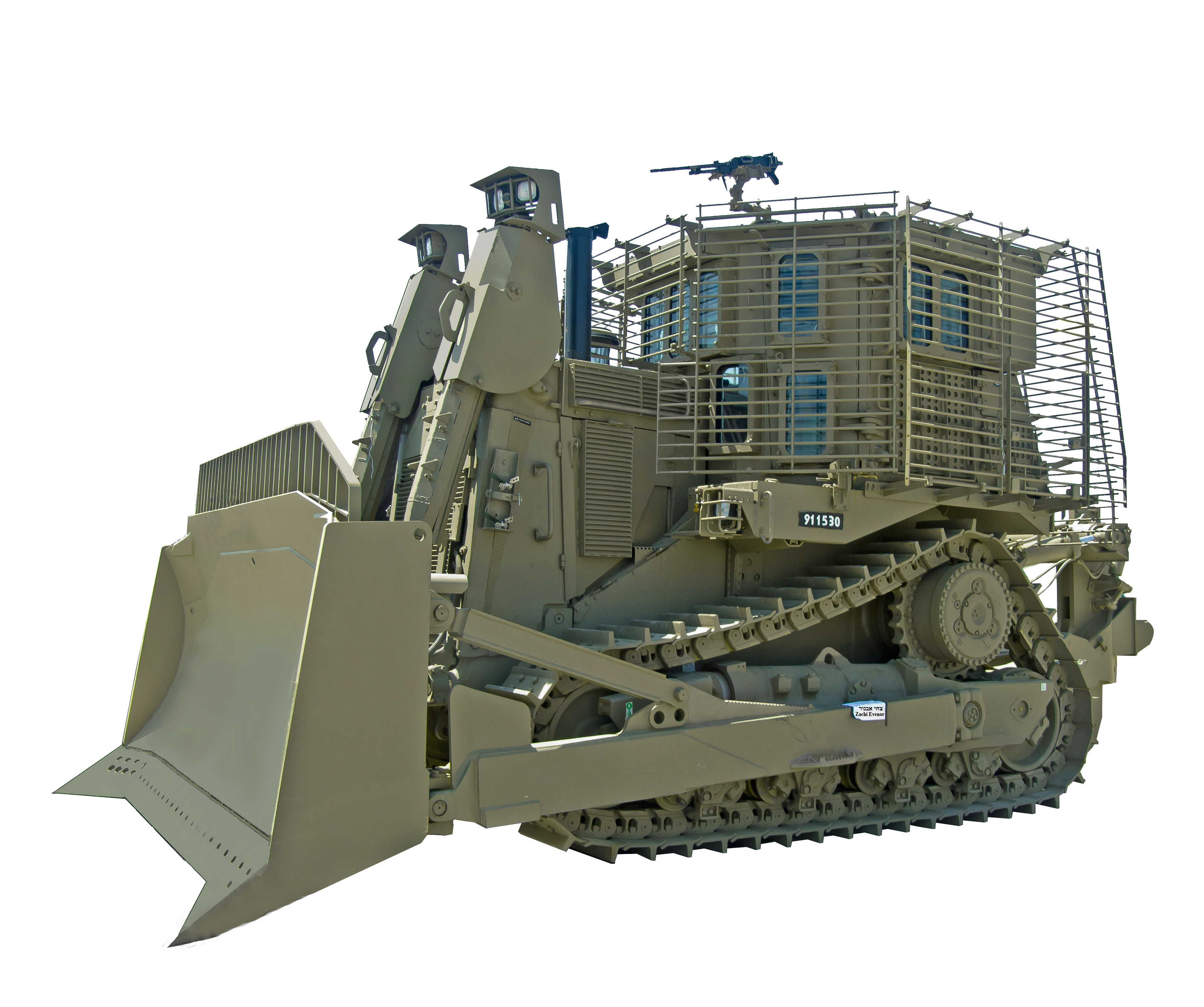Caterpillar D9 on:
[Wikipedia]
[Google]
[Amazon]

 The Caterpillar D9 is a large track-type
The Caterpillar D9 is a large track-type
 Caterpillar Inc. does not manufacture a military version of the D9. However, the attributes that make the D9 popular for major construction projects make it desirable for certain military applications.
The US Army used D9 bulldozers to clear forest in the
Caterpillar Inc. does not manufacture a military version of the D9. However, the attributes that make the D9 popular for major construction projects make it desirable for certain military applications.
The US Army used D9 bulldozers to clear forest in the
File:IDF-D9-demolishes-Palestinian-structure-01.jpg, IDF Caterpillar D9L razing a Palestinian house
File:D9-IDF-1460a.jpg, IDF Caterpillar D9R pushing soil for an earthworks.
Caterpillar D-Series Track-Type Tractors
– Official Caterpillar website
– The US army tests the armoured D9R for the Iraqi campaign {{Caterpillar Military engineering vehicles Caterpillar Inc. vehicles Tracked vehicles Bulldozers Tractors Vehicles introduced in 1954

 The Caterpillar D9 is a large track-type
The Caterpillar D9 is a large track-type tractor
A tractor is an engineering vehicle specifically designed to deliver a high tractive effort (or torque) at slow speeds, for the purposes of hauling a Trailer (vehicle), trailer or machinery such as that used in agriculture, mining or constructio ...
designed and manufactured by Caterpillar Inc. It is usually sold as a bulldozer
A bulldozer or dozer (also called a crawler) is a large tractor equipped with a metal #Blade, blade at the front for pushing material (soil, sand, snow, rubble, or rock) during construction work. It travels most commonly on continuous tracks, ...
equipped with a detachable large blade and a rear ripper attachment.
The D9, with 354 kW (474 hp) of gross power and an operating weight of , is in the upper end of Caterpillar's track-type tractors, which range in size from the D2 69 kW (92 hp), , to the D11 698 kW (935 hp), .
The size, durability, reliability, and low operating costs have made the D9 one of the most popular large track-type tractors in the world.
As the size, power, and weight of the larger track-type tractors dictate that they are used primarily for major projects, the D9 is most commonly found in construction, demolition, forestry, mining, waste, and quarry operations.
Engineering and technical description
The D9 is a series of heavy tracked-type tractors, carried oncontinuous track
Continuous track or tracked treads are a system of vehicle propulsion used in tracked vehicles, running on a continuous band of treads or track plates driven by two or more wheels. The large surface area of the tracks distributes the w ...
s and usually used as bulldozer
A bulldozer or dozer (also called a crawler) is a large tractor equipped with a metal #Blade, blade at the front for pushing material (soil, sand, snow, rubble, or rock) during construction work. It travels most commonly on continuous tracks, ...
s. The series began in 1954 with a prototype tractor called the D9X. Ten D9X prototype models were built in 1954. In 1955, the D9 was introduced to compete against the more powerful Euclid TC-12. The D9 came equipped with a 1,473 cid D353, which powered the D9 until the 1980 introduction of the D9L. In 1956, the D9 had its engine power raised to . The new D9E replaced that model in 1959. Two years later, the legendary D9G was introduced; it remained in production for 13 years; it became the main crawler on many job sites, testifying to its sturdiness and design.
In 1965, West Coast businessman Buster Peterson hooked up a pair of D9Gs to pushload the largest wheel tractor scrapers built. In 1968, Caterpillar bought the rights to this concept, thus the DD9G was created (DD stands for Dual D9G). Peterson also built the first SxS D9G, which has two D9Gs side-by-side, pushing a -wide bulldozer blade.
In 1969, Caterpillar introduced this new SxS D9G. In 1974, the improved D9H was introduced to replace the D9G. The D9H is still the most powerful conventional track-type tractor in company history. The DD9H and the SxS D9H soon followed.
In 1980, the D9L was introduced. The unit featured the same new type of elevated drive sprocket undercarriage as had been introduced on the larger D10 in 1977. The new undercarriage design reduced strain and shock loads on the final drives and gave the "belly pan" more ground clearance. The elevated-drive-sprocket undercarriage is a modular design. To repair the machines, one breaks down the tracks and pulls the drive sprockets out. As a result, one can pull the powershift transmission out of the rear.
The D9L was replaced by the D10N in 1987. The D9N replaced D8L in 1987 (this was due to a model number/size adjustment by Caterpillar in their larger bulldozer lineup at the time, allowing them to introduce a smaller D8N model below the larger D8L size). Due to the model adjustment, the D9L is the most powerful D9 in history, with a flywheel power of . The D9L is also the heaviest D9 in history at .
In 1988, Caterpillar produced their 25,000th elevated-drive-sprocket track-type tractor, a D9N. The D9R replaced the D9N in 1996. The D9T replaced the D9R in 2004. The main difference between the D9T and the D9R is the installment of the new Cat C18 ACERT inline-six engine in the D9T vs the V8 3408 HEUI in the D9R. The D9R has clutch and brake steering, while the D9T has differential steering. The D9T has a low-emissions ACERT diesel engine. The current model is the D9 (no letter); however, older models such as the D9T, D9R, D9N, and D9L are still commonly used. The L, N, R, and T models of the D9 are visually very similar, differing primarily in the design of their internal systems.
Tools
The D9's primary working tools are the blade, affixed to the front and controlled by fourhydraulic
Hydraulics () is a technology and applied science using engineering, chemistry, and other sciences involving the mechanical properties and use of liquids. At a very basic level, hydraulics is the liquid counterpart of pneumatics, which concer ...
cylinders, and an optional ripper in the rear.
The blade is mainly intended for earthmoving and bulk material handling: pushing up sand, soil, and rubble. It also can be used to push other heavy equipment such as earthmoving scraper pans, and in military applications, aid main battle tank
A main battle tank (MBT), also known as a battle tank or universal tank or simply tank,Ogorkiewicz 2018 p222 is a tank that fills the role of armour-protected direct fire and maneuver in many modern armies. Cold War-era development of more po ...
s. The dozer blade usually has three variants:
* A straight blade ("S-blade") is short and has no lateral curve, with no side wings, and can be used for fine grading.
* A universal blade ("U-blade") is tall and very curved, and has large side wings to carry more material.
* A "S-U" combination blade is shorter, has less curvature, and has smaller side wings. This blade is typically used for pushing piles of large rocks, such as at a quarry.
The rear ripper is intended for use in loosening rocky ground and ripping out larger stones. It can also break frozen ground and excavate small ditches. The ripper can be replaced with a multi-shank ripper, allowing the bulldozer to comb the ground.
Like many other bulldozers, the D9 can be fitted with other devices, such as mine plows for clearing minefields.
Military applications
 Caterpillar Inc. does not manufacture a military version of the D9. However, the attributes that make the D9 popular for major construction projects make it desirable for certain military applications.
The US Army used D9 bulldozers to clear forest in the
Caterpillar Inc. does not manufacture a military version of the D9. However, the attributes that make the D9 popular for major construction projects make it desirable for certain military applications.
The US Army used D9 bulldozers to clear forest in the Vietnam War
The Vietnam War (1 November 1955 – 30 April 1975) was an armed conflict in Vietnam, Laos, and Cambodia fought between North Vietnam (Democratic Republic of Vietnam) and South Vietnam (Republic of Vietnam) and their allies. North Vietnam w ...
, but after the war they were replaced with smaller and cheaper Caterpillar D7G bulldozers. D7G bulldozers are still very common in US combat engineering
A combat engineer (also called pioneer or sapper) is a type of soldier who performs military engineering tasks in support of land forces combat operations. Combat engineers perform a variety of military engineering, tunnel and mine warfare tas ...
battalions; currently the US Army fields around 1300 D7r’s that are a combination of armored and non armored. A series of suggestions have been made to replace the lighter D7Gs with the newer and more heavily armored D9s.
The Israel Defense Forces
The Israel Defense Forces (IDF; , ), alternatively referred to by the Hebrew-language acronym (), is the national military of the State of Israel. It consists of three service branches: the Israeli Ground Forces, the Israeli Air Force, and ...
(IDF) have used the D9 since it was introduced.. The armored IDF Caterpillar D9 was introduced in 1986 on the D9L. Fitted with an Israeli-developed vehicle armor kit, and modified variously by the Israel Defense Forces, Israeli Military Industries and Israel Aerospace Industries, it has proven particularly effective.
IDF D9 bulldozers were used during the Second Intifada
The Second Intifada (; ), also known as the Al-Aqsa Intifada, was a major uprising by Palestinians against Israel and its Israeli-occupied territories, occupation from 2000. Starting as a civilian uprising in Jerusalem and October 2000 prot ...
(2000–2005) to demolish Palestinian structures and clear improvised explosive device
An improvised explosive device (IED) is a bomb constructed and deployed in ways other than in conventional warfare, conventional military action. It may be constructed of conventional military explosives, such as an artillery shell, attached t ...
s. The Israeli armor provides protection from small arms and explosives, and the bulldozers were used the Battle of Jenin 2002 during Operation Defensive Shield. A 2003 incident involving an IDF D9, in which a 23-year-old American activist was killed, resulted in a lawsuit brought against Caterpillar, Inc. in the United States. The court dismissed the case on grounds that it was outside their jurisdiction, and that Israeli tort law was a sufficient avenue to pursue remedies.
The D9 remains one of the main combat engineering tools of the IDF, which currently deploys the D9L, D9N, D9R, and D9T. Most of the IDF's D9 fleet today are composed of the D9R with slat armor..
A similarly modified armored D9 was also used by KBR in Iraq.
See also
* Rome plow * ''Killdozer!'' (film)References
External links
Caterpillar D-Series Track-Type Tractors
– Official Caterpillar website
– The US army tests the armoured D9R for the Iraqi campaign {{Caterpillar Military engineering vehicles Caterpillar Inc. vehicles Tracked vehicles Bulldozers Tractors Vehicles introduced in 1954